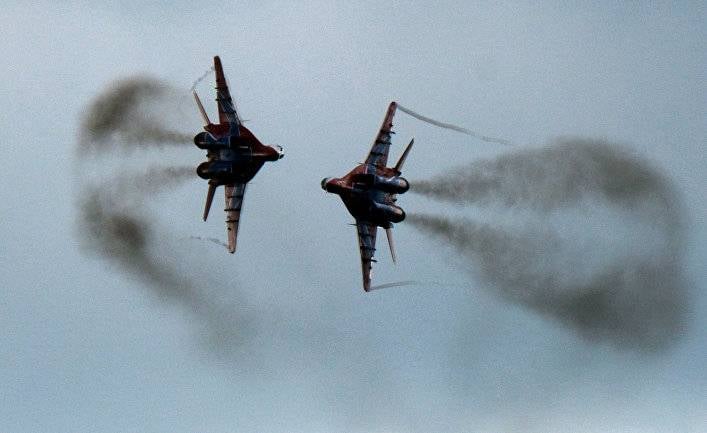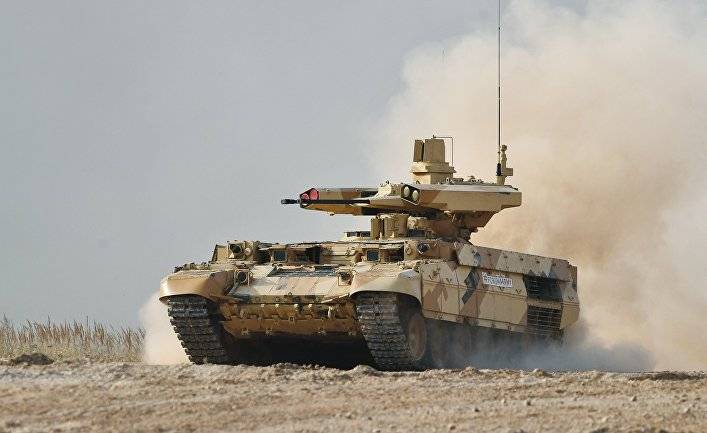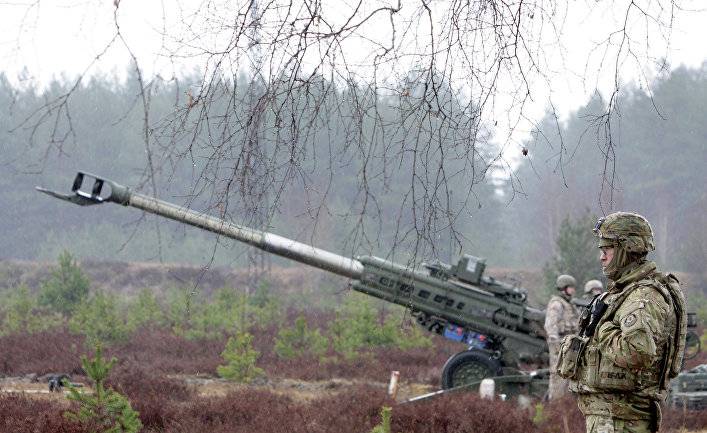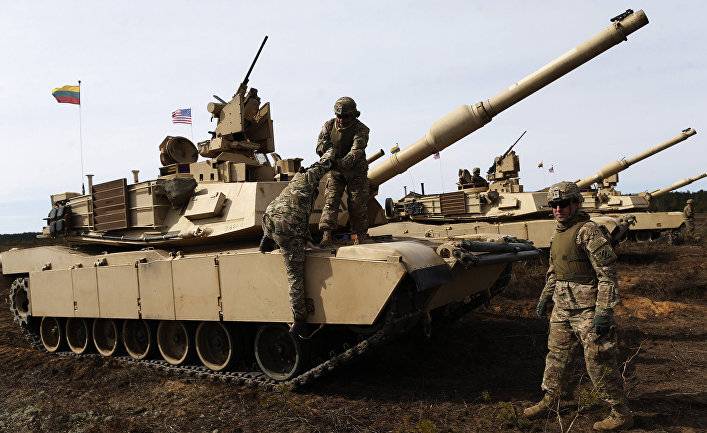Does America give Russia its military superiority?

The current tensions between Russia and NATO are forcing many to carefully assess this issue and examine the current state of the Russian armed forces, as well as the level of their technological equipment, in order to better understand the dimensions of the threats they represent.
Of course, the Russian military exercises, as well as the annexation of the Crimean peninsula, forced many Pentagon analysts to become interested in the current Russian military modernization and the pace of its implementation, as well as to assess the relative condition of the armed forces of this giant of the Cold War, its platforms and military equipment.
Russia in response to NATO’s actions clearly took the position as if it were able to counterbalance the Alliance or restrain it, but when studying the current state of the Russian armed forces, questions arise about Russia's ability to challenge NATO in a prolonged and full-scale military clash.
Nevertheless, Russia continues to pursue military successes, and many Pentagon experts and its analysts express concern about the situation of NATO forces in Eastern Europe and ask whether the forces of the North Atlantic Alliance are sufficient to keep Russia from possibly invading Eastern Europe. .
In addition, Russia's economic pressure could not slow down its program of rapid military modernization and an increase in the defense budget, despite the fact that its modern forces are only part of what the USSR had at the height of the cold war in the 1980s.
Although today the territories of the former giant of the Cold War and its external borders are much smaller than those in 1980's, ordinary land, air force and naval forces of Russia are trying to develop rapidly, move into the high-tech information age and constantly develop the next generation platforms .
The Russian conventional and nuclear arsenals represent a small part of what happened during the Cold War, but it is developing a new class of air-independent submarines, a subtle T-50 fighter, next-generation missiles, and individual high-tech equipment for infantrymen.
The National Interest Research Center recently published a large number of articles on the technological progress currently achieved by Russian military developers. Various laudatory publications are devoted, among other things, to the new Russian anti-satellite arms, tanks T-14 Armata, air defense and initial plans to create a sixth generation hypersonic fighter. Russia unequivocally emphasizes the importance of the ongoing military modernization and is achieving significant success in this area - this is the conclusion of the authors of publications in the journal National Interest, as well as other publications.
So, for example, according to the National Interest magazine, Russia, apparently, conducted a successful launch of its direct launch anti-satellite rocket into Nudol orbit.
“This is the second test of a new weapon capable of destroying satellites in space. This rocket, most likely, was launched from the cosmodrome in Plesetsk, located north of Moscow, “- noted in an article published in the magazine National Interest.
In addition, Dave Majumdar, editor of National Interest magazine, reported that the Russian Airborne Forces are planning to form six tank companies, equipped with the recently upgraded T-72B3M tanks. Over the next two years, these six companies will be enlarged to the battalion, this article emphasizes.
According to reports, Russia is also developing the so-called “Terminator-3”, a tank support combat vehicle.
During the Cold War, the Soviet defense budget accounted for almost half of all state spending.

BMPT Terminator-3 fighting vehicle
Currently, Russian military spending accounts for a smaller percentage of government spending. But, despite the huge difference in the percentage of spending compared to 1980-s, the Russian defense budget is beginning to increase again. Between 2006 and 2009, according to the Business Insider website, the Russian defense budget increased dramatically — from 25 billion dollars to 50 billion dollars, and in 2013, it was almost 90 billion dollars.
In general, the Soviet armed forces during the Cold War — in terms of only their size — were probably five times larger than the Russian ones now.
In 2013, according to the portal globalfirepower. com, the current Russian army consisted of 766 thousand people, as well as 2,4 million reservists. During the Cold War, there were between three and four million people in the Soviet army.
Currently (estimated at 2013 year), the Russian armed forces include more than 3 thousands of aircraft and a 973 helicopter. As for the ground forces, then, according to the portal globalfirepower. com, Russia has 15 thousands of tanks, 27 thousands of armored combat vehicles and about 6 thousands of self-propelled artillery. Although conventional weapons in Russia appear to be smaller in size than the Soviet Union had during the Cold War, the Russian military is making efforts both in the field of modernization and in maintaining some of their motorized weapons and platforms. For example, the Russian T-72 tank has been upgraded several times since its creation in the 1970-s.
As for the naval fleet overall, then, as estimated by the globalfirepower portal. com, Russia has 352 ships, including one aircraft carrier, 13 destroyers and 63 submarines. The Black Sea is a strategically important area for Russia for economic and geopolitical reasons, since it provides access to the Mediterranean Sea.
Analysts also believe that a huge number of conventional and nuclear weapons were produced in the USSR in the 1980s, from missile systems and cruise missiles to effective air defense systems.
In fact, the Russian C-300 and C-400 anti-aircraft missile systems, provided they are properly maintained and upgraded, can be particularly effective, experts say.
Referring to Russian news sources, National Interest magazine reported that the Russians are currently testing a new S-500 anti-aircraft missile system capable of shooting down targets at an altitude of up to 200 kilometers.
As for the air force, the Russians continue to use the Su-1980 fighters built in 27, which the Russian military have deployed in all strategically important areas of the country.
The Su-27 fighter is often compared to the American F-15 Eagle fighter. The Russian aircraft - a maneuverable fighter with two engines - was created in 1980-ies primarily to gain air superiority.
War Games of the RAND Corporation
While many experts believe that the size of NATO, firepower, air superiority and technology will ultimately ensure victory in the event of a serious military confrontation with Russia, this does not necessarily refute the findings of a study by RAND, which It was published more than a year ago and it said that NATO would be in an extremely difficult situation if Russia invades the territory of the Baltic states.
The armed forces of NATO in Eastern Europe in the coming years will not be able to counter the Russian invasion of neighboring Lithuania, Latvia and Estonia, according to a study by RAND.
After a significant series of war games in which “red” (Russians) and “blue” (NATO) turned out to be involved in a large number of military scenarios about the Baltic states, in a study of RAND Corporation entitled “Strengthening deterrence on NATO’s eastern flank” (Reinforcing Deterrence on NATO's Eastern Flank) concludes that the successful defense of NATO of this region will require a much larger amount of ground forces than the North Atlantic alliance currently has.
In particular, this study calls for the development of a NATO strategy similar to the 1980’s AirLand Battle doctrine. At that time, the US ground forces had at least several hundred thousand soldiers in Europe as part of a strategy designed to deter possible Russian aggression. US ground forces officers told Scout Warrior magazine reporters that 30 thousands of American soldiers are currently stationed in Europe.
The RAND study concluded that without deterrence forces in at least seven brigades, as well as fire and air support for the defense of Eastern Europe by NATO, Russia could capture the Baltic states in just 60 hours.

NATO unit servicemen at the Adazi range in Latvia
“At present, NATO is unable to successfully protect the territory of these most endangered members of the Alliance. Based on the analysis of a large number of games involving both military and civilian experts from both sides, it can be said that the Russian armed forces will reach the suburbs of the Estonian capital and / or Latvia in 60 hours (respectively, Tallinn and Riga). Such a quick defeat will leave a limited number of options at the disposal of NATO, ”the study emphasized.
An “airborne” operation is a concept of warfare that was adopted by the US and Allied forces during the Cold War. Among other things, it was based on precise coordination between large mechanized ground forces and an assault force. aviation in the sky. Part of this approach consisted of delivering air strikes against the rear zones to weaken the enemy’s ability to supply all the necessary front-line units. As a result of this kind of air-ground integration, significant conventional forces are able to move forward more easily through the fortified enemy front lines.
The swift attack on the Baltic region will deprive NATO of most of the attractive options, including the possibility of conducting a large-scale counterattack, and then the following options will remain open - either to threaten the use of nuclear weapons or simply allow the Russians to annex the Baltic countries.
This study also provides one of the limited options that can take a tremendous amount of time to mobilize and form large forces to carry out a counteroffensive, which is likely to lead to a long and bloody battle. Another possibility may be to threaten the use of nuclear weapons, but such a scenario seems unlikely and completely unrealistic in light of the American strategy aimed at reducing nuclear arsenals and preventing the use of nuclear weapons, the study said RAND.
The third and last option mentioned in this study is simply to cede the Baltic states and plunge the Alliance into a situation of a much more intense Cold War. This option, of course, will not be welcomed by many residents of these countries, and as a result of NATO, of course, will be weakened or even partially destroyed.
This study is said to be necessary to create reliable and effective deterrence based on the results of the war games.
“The results of the games held show that the group consists of approximately seven brigades, including three armored brigades — they must have adequate air cover, fire support on the ground, and, moreover, they must be ready for battle from the very beginning of the armed conflict,” may be sufficient to prevent the rapid seizure of the Baltic states, ”the RAND study notes.
In the course of studying various scenarios of war games, their participants came to the conclusion that NATO resistance could be quickly broken if more substantial mechanized defensive forces were not deployed.
“The lack of short-range air defense in the United States, as well as minimal defensive capabilities in other parts of NATO, meant that many of these attacks were resisted only by NATO combat air patrol forces that were suppressed at the expense of simple numerical superiority. As a result, several battalions of the "blue" (NATO) suffered great losses, and the preparation for the counteroffensive was violated, ”the study notes.
Latvia, Lithuania and Estonia may turn out to be possible Russian targets - all three countries are located in close proximity to Russia and, moreover, for many years they have been part of the Soviet Union, the study notes.
“Like in Ukraine, there is a significant Russian population in Estonia and Latvia, which, at best, is unequally integrated into the political and social mainstream of these two countries after their independence, which gives Russia self-justification for interfering in Estonian and Latvian affairs”, underlined in a study by RAND.
According to experts from RAND Corporation, the deployment of additional brigades will be a worthy, albeit an expensive step for NATO.
The formation of three new tank brigades and their inclusion in the US Ground Forces will not cost a lot of money - upfront costs for all equipment for three brigades and attached artillery, air defense and other units will be about 13 billions of dollars.
However, most of this equipment — especially the costly Abrams tanks and Bradley infantry fighting vehicles — already exists, this study highlights.

US military on tank M1A2 Abrams during exercises in Pabrad, Lithuania
At present, the presence of NATO troops in Eastern Europe is still being studied by the new administration, and there may be changes in this matter. For quite a long time, NATO and the United States have been discussing the possibility of sending more soldiers to the eastern flank as an additional measure aimed at deterring Russia.
The European Security Initiative proposed by the Pentagon last year (European Reassurance Initiative) calls for additional funding, an increase in the number of personnel and rotation in Europe in the coming years, but it is not yet clear what exactly these forces will be.
At the same time, the Pentagon’s request to get 3,4 a billion dollars to implement the European Security Initiative, in fact, calls for an expansion of the military presence in Europe, as well as the accumulation of “firepower”, “pre-located warehouses” and “command posts” there NATO.
Officials from the US Ground Forces in Europe told Scout Warrior magazine that they are considering the possibility of conducting additional solidarity maneuvers with NATO allies in Europe, and also sending additional numbers of soldiers there.
For example, NATO conducted an exercise in Poland and in Germany under the name “Swift Response 27” from Poland from May 26 to May 16 in June last year; 16 of thousands of soldiers and pilots from the United States, Belgium, France, Germany, Great Britain, Italy, Holland, Poland, Portugal and Spain took part in them.
Information